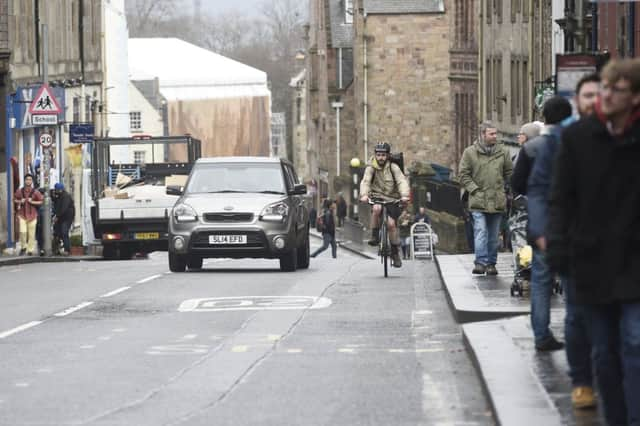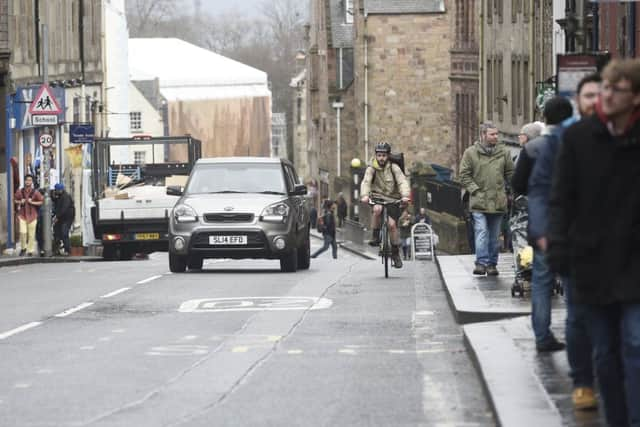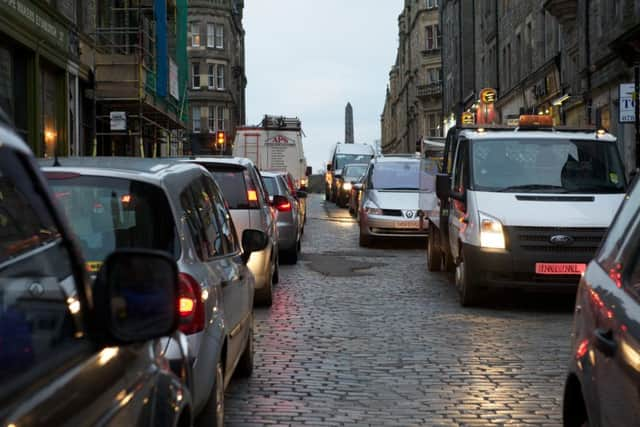Cars face ban from parts of Edinburgh's city centre in major shake-up


Drivers in the Capital are facing a raft of new restrictions on where they can and can’t drive in and around the Old and New Towns, in a bid to hand more space to people travelling on foot and bicycle.
It is hoped the measures can help protect key routes in and around the capital’s World Heritage Site, as well as tackle the “congested and cluttered” state of many roads during peak tourism and festival seasons.
Advertisement
Hide AdAdvertisement
Hide AdThe plans, set to be drawn up by city leaders, have been tentatively welcomed by some business leaders, who said it could make the city centre a more pleasant place to walk around.


But some residents have criticised the plans, warning it could turn Edinburgh into a “ghost city”.
Bus companies are already in talks with council officials about the possibility of re-routing some services to help tackle growing over-crowding problems on roads and pavements. An official report for councillors has warned “the city needs to take action now” to protect quality of life and its natural and built environment.
It states: “As a compact, walkable city, Edinburgh’s public realm does not always provide the best pedestrian experience. Congested historic streets, narrow footways, increased footfall, street clutter, the variable quality of materials and long wait times at crossings, frustrate safe and convenient movement.


Advertisement
Hide AdAdvertisement
Hide Ad“Edinburgh has an active and growing cycling culture with more people benefitting from this healthy, accessible and pollution-free way to get around. However, cyclists must negotiate conflicts with cars, public transport and pedestrians.
“The public transport system is the envy of many other cities, yet its high patronage results in several thousand bus movements per day on Princes Street and crowded bus stops across the city.”
Council leader Adam McVey said: “We are taking forward a fundamental look at how the city centre works in terms of transport. That could mean quite a lot of change.
“Other cities around the world have managed increasing numbers, which is driven either by population or tourism, they have looked to maximise space by diversifying transport uses.


Advertisement
Hide AdAdvertisement
Hide Ad“I would expect us to look at having less private cars and better public transport.
“We need to make sure people can still access the city centre, but in a way that maximises the space. We can’t increase the size of the city centre.
“We’re spending a lot of time with Lothian Buses looking at Princes Street, George Street and Queen Street and how their routes across the city centre work.
“This isn’t about the council deciding what it is going to do. It’s about engaging with public transport operators and other partners, businesses, residents and everyone else who has an interest in the city centre.


Advertisement
Hide AdAdvertisement
Hide Ad“You can’t drive where you want in other cities and they are all the better for it. They have better spaces and better public realm.
“We’re not aiming to eradicate private cars, that would be ridiculous. Everybody has to acknowledge that you cannot drive everywhere all the time.”
Council transport leader Lesley McInnes added: “We are absolutely committed to making Edinburgh a better place to live and work. This is about looking at what improvements can be made to achieve this from an environmental, social and economic perspective.
“We believe the key to this is creating a better quality of public space, enhancing the pedestrian experience and reducing congestion.
Advertisement
Hide AdAdvertisement
Hide Ad“While we are at the early stages, this project aims to improve conditions for access for pedestrians, cyclists and public transport in the city centre.”
A spokeswoman for the council said it was due to launch an official consultation process on a “Central Edinburgh Transformation” initiative in May, with a detailed plan of action due to be published in the spring of 2019.
The council spokeswoman added: “The main aim and ambition of the project is to build on the strengths and qualities that have served the city well in the past and, at the same time, shape it for the future.
“In a fast-changing environment, the city centre must remain the heart of the city’s cultural and civic life, the focal point for its economy and one of Scotland’s most iconic and important locations.
Advertisement
Hide AdAdvertisement
Hide Ad“This project will look at the city centre as a place to live, work and visit and aspire to make the changes needed to meet the city’s growing needs and demands. This project aims to create an action plan for a city that is sustainable, healthy and safe for our future generations.
“The successful co-existence of people who live, work and play in the city centre, spread across an extraordinary topography and urban form, is what makes Edinburgh the special place it is and what gives it its World Heritage Site status. But for all of Edinburgh’s outstanding qualities, some streets and spaces of the city centre remain congested and cluttered.
“Edinburgh is also a growing city. It is expanding faster than any other UK city and by 2040 will have a population of 600,000. A growing city needs a city centre that works for everyone across all its functions. To pull this together we will prepare a plan that sets out a clear ambition for the city centre in the context of the wider city evolution.
“We want to reduce congestion in the city centre and believe the key to doing this is improving the efficiency of public transport and investing in walking and cycling infrastructure.
Advertisement
Hide AdAdvertisement
Hide Ad“Making it easier to walk or cycle through high quality infrastructure as well as communicating the impact and benefit of high quality public realm on people’s health and well-being, are key components of creating a change in behaviour and a shift away from private cars.
“The process of evidence-gathering and consultation data will allow for idea generation and scenario testing. However, we are not at this stage of the process yet. We will continue to work closely with Lothian Buses and other bus operators on the project at every stage to test scenarios and develop solutions that fulfil the project aims and objectives.”
Manager of the Three Sisters bar on Cowgate, Carl Boyle, said: “I’d definitely support it, especially at peak times.
“Obviously the Cowgate is already pedestrianised at certain times over the weekend, has been for a couple of years, and that’s definitely helped us out. It means better access for us though it wouldn’t benefit us as much midweek.”
Advertisement
Hide AdAdvertisement
Hide AdDavid Nemeth of Hendersons vegetarian cafe on Hanover Street also backed the plans for making the Capital a more attractive city to walk around.
“I think reducing traffic in any city centre is a good thing,” he said. “Parking spaces are pretty strict and there’s not enough so more people come to us by foot. We don’t have parking, we don’t provide any spaces – even for our own vehicles.
“Our customers are mainly pedestrians – they walk here or come on the bus. I think making the streets more walkable, more romantic and accessible is good. Coming on foot is also better for the area and makes you appreciate the surroundings.”
Assistant head concierge at the iconic Balmoral hotel on Princes Street, Andy Fraser, said he could see “both sides” of the plans. While reducing traffic can only be good for the city’s world heritage status, it could make life more difficult for guests trying to reach the hotel, said Mr Fraser.
Advertisement
Hide AdAdvertisement
Hide Ad“The less traffic the better, obviously,” he added. “But our guests can have issues getting to the hotel by car – they get stuck because they don’t realise only buses and taxis can go down Princes Street. You’ve got the two world heritage sites of the New Town and the Old Town and it’s never going to be a driver-friendly city because of how old it is. The New Town is 251 years old this year and it wasn’t designed for cars, or even trams, it was horse and cart back then – and the Old Town is even older.”
Mr Fraser said the temporary closure of Leith Street is already causing problems for guests. “Sometimes I’d like to see Princes Street revamped – pedestrianised and keeping the trams,” he added.
‘What the City Needs is an inner ring road’
Evening News readers have their say.
Peter Chalmers: “Is this an April Fool? Or are the Council seriously stopping cars and buses from city centre? Welcome to ghost city Edinburgh if that happen.”
William Kay: “I sometimes have a wee chuckle when people portray this as an unmitigated disaster yet some places abroad already do this and have done for decades and everything’s fine. They do usually allow buses and trams to stay in situ.”
Advertisement
Hide AdAdvertisement
Hide AdAlly Miller: “People have legs and can walk around – which is the point of having less traffic.”
Diamond Walls: “Every Lothian Bus route bar two hit Princes Street at some point, also it’s not the people like me who live in the city centre that cause the problem it’s the ones travelling from outwith the centre. That said, Councillor McVey needs to tell the central residents how you pay different parking charges for residents permits depending on your emissions, but metre parking is charged, at the same rate for the zone, no matter what your emissions are.”
Brian Stewart: “McVey needs to realise tourists do not generally drive cars and that the majority of the problems are caused by Lothian Buses. We need some people with common sense involved in this.”
Kacey Milne: “For pedestrians read tourists. All this council are interested in. Their aim is making the lives of the ordinary residents as difficult as possible so that we move out. Residents demand services which cost money,tourists bring in money. I’d love to find out which councillors have financial interests elsewhere.”
Advertisement
Hide AdAdvertisement
Hide AdTavy Fraser: “You have to admit that quite a lot of the city centre shouldn’t have masses of traffic through it.
“A lot of the streets are narrow and can’t be widened without knocking down historic buildings. Even if you ignored junctions and traffic lights, the city centre is a massive bottleneck. Then you do factor in other roads intersecting that need traffic management, and there’s a reason it’s always packed solid a lot of the day. What it needs is an inner ring road, though that has the issues of historic buildings too.”
